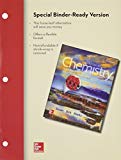
Concept explainers
(A)
Interpretation:
Whether the response, “The solution is
(A)
Explanation of Solution
Consider the given statement, “The dissolution process of
The given response is incorrect because in water,
(B)
Interpretation:
Whether the response, “ The solution is
(B)
Explanation of Solution
The given statement, “The dissolution process of
In water,
Therefore, the given response is an incorrect response.
(C)
Interpretation:
Whether the response “ The solution is
(C)
Explanation of Solution
The given statement, “The dissolution process of
The mole ratio of
So, the concentration of
The concentration of
Hence, the given response is correct as it best describes the dissolution process of
(D)
Interpretation:
Whether the given response, “The solution is
(D)
Explanation of Solution
The given statement, “The dissolution process of
The total concentration of the ions present in the aqueous solution is calculated by adding the concentration of both magnesium and nitrate ions.
Since the total concentration of ions in the solution is
(E)
Interpretation:
Whether the given response, “
(E)
Explanation of Solution
Consider the given statement, “The dissolution process of
Therefore, the given response is an incorrect response.
Want to see more full solutions like this?
Chapter 11 Solutions
Combo: Loose Leaf for Introduction to Chemistry with Connect Access Card Chemistry with LearnSmart 1 Semester Access Card
- 12.17 Which of the following is more likely to precipitate sulfate ions? PbSO4(s) Pb*+(aq) + SO42’(aq) K = 1.8 X IO"8 CaSO4(s) i=i Ca2+(aq) + SO42'(aq) K = 9.1 X 10-6arrow_forwardA solution contains Ca2+ and Pb2+ ions, both at a concentration of 0.010 M. You wish to separate the two ions from each other as completely as possible by precipitating one but not the other using aqueous Na2SO4 as the precipitating agent. (a) Which will precipitate first as sodium sulfate is added, CaSO4 or PbSO4? (b) What will be the concentration of the first ion that precipitates (Ca2+ or Pb2+) when the second, more soluble salt begins to precipitate?arrow_forwardSome of the substances commonly used in stomach antacids are MgO, Mg(OH)2, and Al(OH)3. a. Write a balanced equation for the neutralization of hydrochloric acid by each of these substances. b. Which of these substances will neutralize the greatest amount of 0.10 M HCl per gram?arrow_forward
- A scientist has synthesized a diprotic organic acid, H2A, with a molar mass of 124.0 g/mol. The acid must be neutralized (forming the potassium salt) for an important experiment. Calculate the volume of 0.221 M KOH that is needed to neutralize 24.93 g of the acid, forming K2A.arrow_forwardWhich of the following is more likely to precipitate the hydroxide ion? Cu(OH)2(s) *=» Ctr+(aq) + 2 OH’(aq) K = 1.6 X IO-19 Ca(OH)2(s) *=» Ca2+(aq) + 2 OH’(aq) K = 7.9 X 10"6arrow_forwardVitamin C has the formula C6H8O6. Besides being an acid, it is a reducing agent. One method for determining the amount of vitamin C in a sample is to titrate it with a solution of bromine, Br2, an oxidizing agent. C6H8O6(aq) + Br2(aq) 2 HBr(aq) + C6H6O6(aq) A 1.00-g "chewable" vitamin C tablet requires 27.85 ml of 0.102 M Br2 for titration to the equivalence point. What is the mass of vitamin C in the tablet?arrow_forward
- What mass of solid aluminum hydroxide can be produced when 50.0 mL of 0.200 M Al(NO3)3 is added to 200.0 mL of 0.100 M KOH?arrow_forwardA sample of hard water contains about 2.0 103 M Ca2+. A soluble fluoride-containing salt such as NaF is added to fluoridate the water (to aid in the prevention of dental cavities). What is the maximum concentration of F that can be present without precipitating CaF2?arrow_forwardHydrochloric acid (75.0 mL of 0.250 M) is added to 225.0 mL of 0.0550 M Ba(OH)2 solution. What is the concentration of the excess H+ or OH ions left in this solution?arrow_forward
- Potassium permanganate, KMnO4, is both effective at treating water and has medicinal uses. A certain solution of KMnO4 being prepared to treat water has a concentration of 13.58 % (m/v) Calculate the molar concentration of 13.58 %(m/v) Potassium permanganate .arrow_forwardCalculate the concentration of all ions present in each of the following solutions of strong electrolytes. a.) 0.500 mole of Ca(NO3)2 in 700.0 mL of solution b.) 5.0 moles of Na2SO4 in 7.25 L of solution c.) 5.70 g of NH4Cl in 810.0 mL of solutionarrow_forwardConsider 500.0 mL of a 0.250 M solution of Fe2(SO4)3. What is the concentration of the sulfate ions in this solution?arrow_forward
 Chemistry: The Molecular ScienceChemistryISBN:9781285199047Author:John W. Moore, Conrad L. StanitskiPublisher:Cengage Learning
Chemistry: The Molecular ScienceChemistryISBN:9781285199047Author:John W. Moore, Conrad L. StanitskiPublisher:Cengage Learning Chemistry & Chemical ReactivityChemistryISBN:9781133949640Author:John C. Kotz, Paul M. Treichel, John Townsend, David TreichelPublisher:Cengage Learning
Chemistry & Chemical ReactivityChemistryISBN:9781133949640Author:John C. Kotz, Paul M. Treichel, John Townsend, David TreichelPublisher:Cengage Learning Chemistry & Chemical ReactivityChemistryISBN:9781337399074Author:John C. Kotz, Paul M. Treichel, John Townsend, David TreichelPublisher:Cengage Learning
Chemistry & Chemical ReactivityChemistryISBN:9781337399074Author:John C. Kotz, Paul M. Treichel, John Townsend, David TreichelPublisher:Cengage Learning Chemistry for Engineering StudentsChemistryISBN:9781337398909Author:Lawrence S. Brown, Tom HolmePublisher:Cengage Learning
Chemistry for Engineering StudentsChemistryISBN:9781337398909Author:Lawrence S. Brown, Tom HolmePublisher:Cengage Learning Chemistry: Principles and PracticeChemistryISBN:9780534420123Author:Daniel L. Reger, Scott R. Goode, David W. Ball, Edward MercerPublisher:Cengage Learning
Chemistry: Principles and PracticeChemistryISBN:9780534420123Author:Daniel L. Reger, Scott R. Goode, David W. Ball, Edward MercerPublisher:Cengage Learning ChemistryChemistryISBN:9781305957404Author:Steven S. Zumdahl, Susan A. Zumdahl, Donald J. DeCostePublisher:Cengage Learning
ChemistryChemistryISBN:9781305957404Author:Steven S. Zumdahl, Susan A. Zumdahl, Donald J. DeCostePublisher:Cengage Learning





